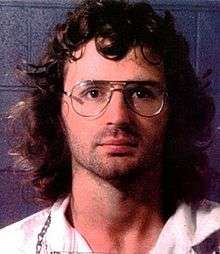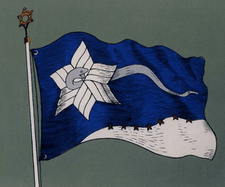Branch Davidians
|
A painting of the Branch Davidian flag | |
| Founder | |
|---|---|
| Benjamin Roden | |
| Regions with significant populations | |
| Branch Davidian Seventh Day Adventists | |
| Mount Carmel |
12
|
| Scriptures | |
| Isaiah 9:7, Ezekiel 9, Hosea 1–2, Micah 6:9, Micah 7:14, Matthew 20, Revelation 7:6, Revelation 13, Revelation 14 | |
The Branch Davidians (also known as "The Branch") are a religious group that originated in 1955 from a schism in the Davidian Seventh-day Adventists ("Davidians"), a reform movement that began as an offshoot from the Seventh-day Adventist Church ("Adventists") around 1930. Some of those who accepted the reform message had been removed from membership of the Seventh-day Adventist Church because of their supplemental teachings.
From its inception in 1930, the reform movement believed themselves to be living in a time when Bible prophecies of a final divine judgment were coming to pass as a prelude to Christ's Second Coming. The name "Branch Davidian" is most widely known for the Waco siege of 1993 on their property (known as the Mount Carmel Center) near Waco, Texas. The 51-day siege, by the ATF, FBI, and Texas National Guard, resulted in the deaths of the Branch Davidians' leader, David Koresh, as well as 82 other Branch Davidian men, women, and children, and four ATF agents.[2][3]
Today, the original Davidian Seventh-day Adventists and the Branch Davidian Seventh-day Adventists are two different and distinct groups. The doctrinal beliefs differ on such teachings as the Holy Spirit and His nature, the feast days and requirements, and who had the prophetic office since Victor Houteff's death.
Early history
In 1929 Victor Houteff, a Bulgarian immigrant and a Seventh-day Adventist Sabbath School teacher in a local church in Southern California, claimed that he had a new message for the entire church. He presented this message in a book, The Shepherd's Rod: The 144,000—A Call for Reformation.[4] The Adventist leadership rejected Houteff's message as contrary to the Adventists' basic teachings and disfellowshipped Houteff and his followers. However, there was some controversy over the method the leadership took to disfellowship Houteff.
In 1935 Houteff established his headquarters to the west of Waco, Texas.[5] After Houteff died in 1955, the segment of the group loyal to Houteff continued as the Davidian Seventh-day Adventists.
A splinter group, the Branch Davidian Seventh-day Adventists, was begun by Benjamin Roden and headed after Roden's death by his wife Lois Roden. After Lois Roden died, a bitter power struggle ensued between Lois Roden's son George Roden and her designated successor David Koresh (then still using his birth name of Vernon Howell), eventually won by Koresh.
Rise of Koresh

David Koresh's arrival on the Waco compound in 1981 was well received by nearly everyone at the Davidian commune. Koresh had an affair with the then-prophetess of the Branch Davidians Lois Roden. When she died, her son George Roden inherited the position of prophet and leader of the commune. However, George Roden and Koresh began to clash. [6] The Commune began to experience internal conflict due to Koresh and George Roden's rivalry. [7] As a result, Koresh suddenly left the commune and settled in Palestine, Texas, where he was joined in 1985 by Branch Davidians who had been run off of the Branch Davidian compound at gunpoint by Roden. Koresh and his followers remained in Palestine for two years, living in squalor, until the conflict between Roden and Koresh came to a head in 1987[8] By this time Koresh now enjoyed the loyalty of the majority of the [Branch Davidian] community" [9] As an attempt to regain support, George Roden challenged Koresh to raise the dead, going so far as to exhume a corpse to demonstrate his spiritual supremacy. This illegal activity gave Koresh an opportunity to attempt to file charges against Roden, however he was told he needed evidence. This led to the November 3rd, 1987 raid on the Mount Carmel Center by Koresh and 7 of his followers equipped with five .223 caliber semiautomatic rifles, two .22 caliber rifles, two 12-gauge shotguns and nearly 400 rounds of ammunition. Their objective seemed to be to retake the land that Koresh had left three years earlier although they claim to have been trying to obtain evidence of Roden's illegal activity, yet they did not come equipped with a camera.[10] The trial ended with the jury finding the followers of Koresh not guilty, but were unable to agree on Koresh. After the followers were found not guilty Koresh invited the prosecutors to Mount Carmel for ice cream. [11]
Waco siege

By the time of the 1993 Waco siege, Koresh had encouraged his followers to think of themselves as "students of the Seven Seals" rather than as "Branch Davidians." During the standoff one of his followers publicly announced that he wanted them to thereafter be identified by the name "Koreshians".[12]
It is claimed that Koresh was never authorised to use the name "Branch Davidians" for his breakaway sect,[13] and that the church of that name continues to represent that part of the Branch church which did not follow him.
Branch, The Lord Our Righteousness
One modern incarnation of The Branch Davidians exists under the leadership of Charles Pace, a former follower of Koresh. Pace left the Branch Davidians in the mid-1980s. He claims that Koresh twisted the Bible’s teachings by fathering more than a dozen children with members’ wives.[14] Pace feels the Lord "has anointed me and appointed me to be the leader" but he claims he is "Not a prophet" but "a teacher of righteousness".[15] Like the Branch Davidians under Koresh, Branch, The Lord Our Righteousness is waiting for the end of times.[16]
References
- ↑ Smyrl, Vivian Elizabeth. "Elk, Texas". Handbook of Texas – Texas State Historical Association. Retrieved 25 November 2012.
- ↑ Gazecki, William; Gifford, Dan; McNulty, Michael. "Waco: The Rules of Engagement (1997)". Film Documentary. IMDb – Internet Movie Database. Retrieved 25 November 2012.
- ↑ Newport, Kenneth G.C. (June 22, 2006). "The Branch Davidians of Waco: The History and Beliefs of an Apocalyptic Sect". Oxford University Press. ISBN 978-0199245741.
- ↑ The General Association of Branch Davidian Seventh Day Adventists. "The Shepherd's Rod, Vol. 1". The-branch.org. Retrieved 2011-03-18.
- ↑ Pitts, William L. "Davidians and Branch Davidians". Handbook of Texas – Texas State Historical Association. Retrieved November 25, 2012.
- ↑ "Biography: David Koresh". PBS. Frontline. Retrieved 21 May 2016.
- ↑ CRI. "The Branch Davidians". equip.org. Retrieved 18 May 2016.
- ↑ CRI. "The Branch Davidians". equip.org. Retrieved 18 May 2016.
- ↑ David G. Bromley and Edward D. Silver (1995). The Davidian Tradition: From Patronal Clan to Prophetic Movement,. in Stuart A. Wright, Armageddon in Waco: Critical Perspectives on the Branch Davidian Conflict: Chicago: University of Chicago. p. 54.
- ↑ "BIOGRAPHY: David Koresh". PBS. Retrieved 23 May 2016.
- ↑ Nossiter, Adam (1993-03-10). "Warning of Violence Was Unheeded After Cult Leader's Gun Battle in '87". The New York Times. ISSN 0362-4331. Retrieved 2016-05-19.
- ↑ "Mr. Ricks [FBI negotiator] said today that Ms. Schroeder had told him that members of the sect, a renegade offshoot of Seventh-day Adventists, henceforth wanted to be known as Koreshians." By Robert Reinhold, Published: March 15, 1993 New York Times [brackets added].
- ↑ The General Association of Branch Davidian Seventh Day Adventists
- ↑ The Associated Press. "Near Waco, a New Fight Over an Old Compound". New York Times. Retrieved 12 May 2016.
- ↑ Burnett, John (April 20, 2013). "Two Decades Later, Some Branch Davidians Still Believe". National Public Radio. Retrieved 12 May 2016.
- ↑ Burnett, John (April 20, 2013). "Two Decades Later, Some Branch Davidians Still Believe". National Public Radio. Retrieved 12 May 2016.
External links
Coordinates: 31°35′46″N 96°59′17″W / 31.596089°N 96.98804°W
